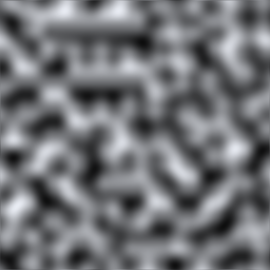Mathf.PerlinNoise
static
function
PerlinNoise(x:
float,
y:
float):
float;
static float PerlinNoise(float x,
float y);
static
def
PerlinNoise(x as float,
y as float)
as float
Returns
float Value between 0.0 and 1.0.
float Value between 0.0 and 1.0.
Description
Generate 2D Perlin noise.
Perlin noise is a pseudo-random pattern of float values generated across a 2D plane (although
the technique does generalise to three or more dimensions, this is not implemented in Unity).
The noise does not contain a completely random value at each point but rather consists
of "waves" whose values gradually increase and decrease across the pattern. The noise can
be used as the basis for texture effects but also for animation, generating terrain heightmaps
and many other things.
Perlin noise sampled in the range 0..10 (the greyscale values represent values from 0..1)Any point in the plane can be sampled by passing the appropriate X and Y coordinates. The same coordinates will always return the same sample value but the plane is essentially infinite so it is easy to avoid repetition by choosing a random area to sample from.

Perlin noise sampled in the range 0..10 (the greyscale values represent values from 0..1)Any point in the plane can be sampled by passing the appropriate X and Y coordinates. The same coordinates will always return the same sample value but the plane is essentially infinite so it is easy to avoid repetition by choosing a random area to sample from.
// Create a texture and fill it with Perlin noise. // Try varying the xOrg, yOrg and scale values in the inspector // while in Play mode to see the effect they have on the noise. // Width and height of the texture in pixels. var pixWidth: int; var pixHeight: int; // The origin of the sampled area in the plane. var xOrg: float; var yOrg: float; // The number of cycles of the basic noise pattern that are repeated // over the width and height of the texture. var scale = 1.0; private var noiseTex: Texture2D; private var pix: Color[]; function Start () { // Set up the texture and a Color array to hold pixels during processing. noiseTex = new Texture2D(pixWidth, pixHeight); pix = new Color[noiseTex.width * noiseTex.height]; renderer.material.mainTexture = noiseTex; } function CalcNoise() { // For each pixel in the texture... for (var y = 0.0; y < noiseTex.height; y++) { for (var x = 0.0; x < noiseTex.width; x++) { // Get a sample from the corresponding position in the noise plane // and create a greyscale pixel from it. var xCoord = xOrg + x / noiseTex.width * scale; var yCoord = yOrg + y / noiseTex.height * scale; var sample = Mathf.PerlinNoise(xCoord, yCoord); pix[y * noiseTex.width + x] = new Color(sample, sample, sample); } } // Copy the pixel data to the texture and load it into the GPU. noiseTex.SetPixels(pix); noiseTex.Apply(); } function Update () { CalcNoise(); }
using UnityEngine; using System.Collections; public class Example : MonoBehaviour { public int pixWidth; public int pixHeight; public float xOrg; public float yOrg; public float scale = 1.0F; private Texture2D noiseTex; private Color[] pix; void Start() { noiseTex = new Texture2D(pixWidth, pixHeight); pix = new Color[noiseTex.width * noiseTex.height]; renderer.material.mainTexture = noiseTex; } void CalcNoise() { float y = 0.0F; while (y < noiseTex.height) { float x = 0.0F; while (x < noiseTex.width) { float xCoord = xOrg + x / noiseTex.width * scale; float yCoord = yOrg + y / noiseTex.height * scale; float sample = Mathf.PerlinNoise(xCoord, yCoord); pix[y * noiseTex.width + x] = new Color(sample, sample, sample); x++; } y++; } noiseTex.SetPixels(pix); noiseTex.Apply(); } void Update() { CalcNoise(); } }
import UnityEngine import System.Collections public class Example(MonoBehaviour): public pixWidth as int public pixHeight as int public xOrg as float public yOrg as float public scale as float = 1.0F private noiseTex as Texture2D private pix as (Color) def Start() as void: noiseTex = Texture2D(pixWidth, pixHeight) pix = array[of Color]((noiseTex.width * noiseTex.height)) renderer.material.mainTexture = noiseTex def CalcNoise() as void: y as float = 0.0F while y < noiseTex.height: x as float = 0.0F while x < noiseTex.width: xCoord as float = (xOrg + ((x / noiseTex.width) * scale)) yCoord as float = (yOrg + ((y / noiseTex.height) * scale)) sample as float = Mathf.PerlinNoise(xCoord, yCoord) pix[((y * noiseTex.width) + x)] = Color(sample, sample, sample) x++ y++ noiseTex.SetPixels(pix) noiseTex.Apply() def Update() as void: CalcNoise()
Although the noise plane is two-dimensional, it is easy to use just a single
one-dimensional line through the pattern, say for animation effects.
// "Bobbing" animation from 1D Perlin noise.
// Range over which height varies.
var heightScale = 1.0;
// Distance covered per second along X axis of Perlin plane.
var xScale = 1.0;
function Update () {
var height = heightScale * Mathf.PerlinNoise(Time.time * xScale, 0.0);
var pos = transform.position;
pos.y = height;
transform.position = pos;
}
using UnityEngine; using System.Collections; public class Example : MonoBehaviour { public float heightScale = 1.0F; public float xScale = 1.0F; void Update() { float height = heightScale * Mathf.PerlinNoise(Time.time * xScale, 0.0F); Vector3 pos = transform.position; pos.y = height; transform.position = pos; } }
import UnityEngine import System.Collections public class Example(MonoBehaviour): public heightScale as float = 1.0F public xScale as float = 1.0F def Update() as void: height as float = (heightScale * Mathf.PerlinNoise((Time.time * xScale), 0.0F)) pos as Vector3 = transform.position pos.y = height transform.position = pos